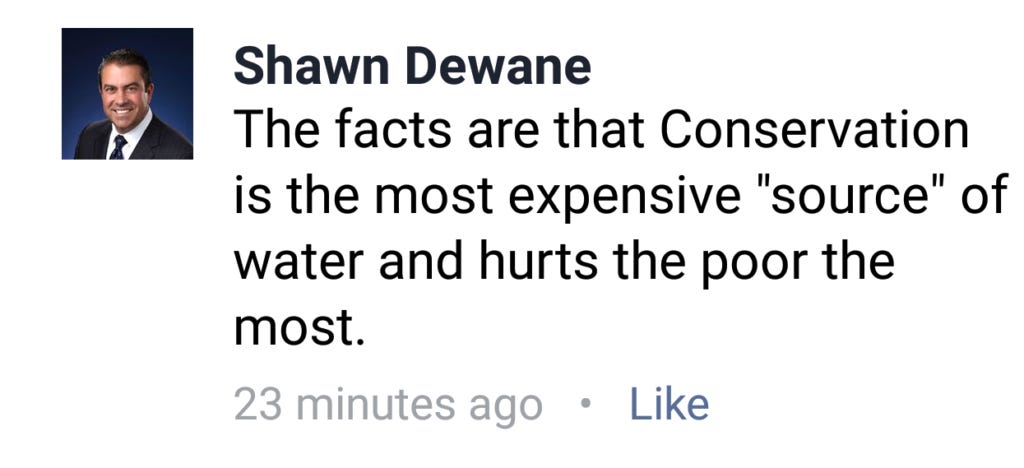Note: This story was fist posted September 4, 2017.
By John Earl
Part 3 in a series: Part 1; Part 2
The Mesa Water District and the Orange County Water District’s dual board member, Shawn Dewane, loves to spin alleged factoids comparing conservation as a water source to the billion-dollar ocean desalination plant that Poseidon Resources wants to build in Huntington Beach.
Dewane plays to his political base, hence his occasional appearance on Costa Mesa Public Square (CMPS), the Facebook page where he reigns as the (mostly) unquestioned authority on all water matters, especially Poseidon.
You can scroll down the CMPS page and see a series of misleading or false assertions made by Dewane related to Poseidon’s proposed project.
For example, on CMPS last April, Dewane posted that “The facts are that Conservation (sic) is the most expensive “source” of water and hurts the poor the most.”
But Dewane’s assertion is false.
Last October, the Pacific Institute, a nonpartisan think-tank that uses “science-based” research to influence “efforts in developing sustainable water policies” worldwide, issued a comprehensive report that analyzes all of California’s water management options (“Cost of Alternative Water Supply and Efficiency Options in California”).
The report concluded that using “urban water conservation and efficiency measures” is the most cost-effective way to meet future water needs and that ocean desalination is the most expensive form of water management.
The study found that, over time, many conservation-efficiency measures save money by creating a negative cost. A more efficient food-steamer, for example, saves 53,000 gallons of water and costs minus $14,000 per acre-foot per year.
By comparison, the cost of water now produced by Poseidon’s Carlsbad ocean desalination plant (nearly identical to its proposed Huntington Beach desalination plant) is plus $2,500 per acre-foot.
If OCWD’s 19 member agencies cut their basin pumping percentage (the amount of water they take from the groundwater basin vs. from more expensive imported water) from 75 percent to 65 percent to conserve water, the replenishment assessment (RA) charged by OCWD to refill the basin (with imported water) and cover fixed costs, would increase by $106 for a total of $508 per acre-foot, according to a OCWD staff report.
That’s about a fifth of what Poseidon charges now in Carlsbad.
Without the Huntington Beach Poseidon project, the RA will go up to $571 an acre foot by 2022; with Poseidon, it will go up to $830 per acre foot.
Comparing the cost of Poseidon water (at the most likely near-future rate) to the cost of the same amount of imported water that OCWD would buy within a year gives a clear-cut picture of the relative costs of conservation and ocean desalination.
The Poseidon plant would produce about 50,000 acre-feet of usable desalinated water per year. At a cost of $2,500 per acre-foot, that comes to $125 million.
The cost of untreated imported water, which the OCWD uses to refill the basin (aside from rainfall percolation), is about $746 per acre foot—or about $37 million per year for 50,000 acre-feet.
The cost of treated imported water, the water OCWD agencies would buy on their own to make up for pumping less groundwater, is $1,059 per acre-foot—or about $53 million per year for 50,000 acre-feet.
By comparing the real costs of desalinated ocean water to the costs of water conservation, it is clear that Dewane’s assertion that conservation is the most expensive source of water is false.
Next: I will look at Shawn Dewane’s claim that state-imposed water restrictions during the drought caused a water price increase that “would have paid for all of the water produced by the Poseidon project” and that “Instead of a new water source, we simply got higher rates and no additional supply.”




